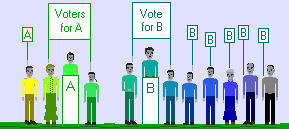|
Different uses for voting
need different types of voting. |
 |
Single-Winner Drawings |
 |

Visualize finding the most central and broadly popular candidate.


|
PoliticalSim lets you play with many voting systems -- and by playing, learn patterns that tend to result from each rule. You may download PoliticalSim. |


|
Three issue dimensions: To get such a well-balanced constellation of winners requires a multi-winner district and an ensemble rule: The chairperson (C in this picture) is elected by a Condorcet rule while the other reps are elected by proportional representation. |
| The ballot-design page showed how preference ballots let voters rank the candidates as first choice, second choice, and so on. The tally-table page tells how ballots are tallied and candidates are compared. But voters don't need to do the counting. For most people, it is enough to know that Condorcet's rule finds the one candidate who can win a majority over any other one. |
The Instant Runoff page explains a rival method to elect a single winner. The page on voting strategies tells how voters and politicians can manipulate plurality rules and why Condorcet’s rule resists most schemes. The page on voting districts graphically shows how easily politicians create districts that predetermine election results. The pictures above have shown how Condorcet's rule minimizes the effects of such gerrymanders. 
|
| |||||
|---|---|---|---|---|---|
| Electoral Systems | Legislative Systems | ||||
Reps
| Council
Condorcet chair plus PR reps | Policy

Condorcet and rules of order | Projects
| Budgets
| |

|
|








 Accurate Democracy
Accurate Democracy 


